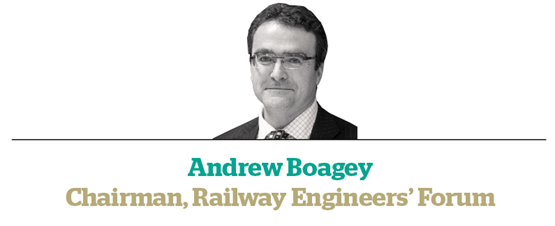
As an engineering student, I used to know what ‘efficiency’ meant. We had a formula. It was quite simple when
applied to engines or lamps. It could even be applied to power plants. It did not have any units, because it was just a ratio or a percentage - we simply divided the use we got out of something by the energy expended on it and the number was (hopefully) meaningful. But when you learn that a light bulb is around 2% efficient at producing light and around 98% efficient at heating a room, you do start to wonder at the value of the exercise.
Is this ever going to work for a complicated system such as a railway, or a capital investment programme? The answer has to be ‘yes’, or we will surely all end up in chaos. It must be true that, as they say: “If you cannot measure it, then you cannot manage it!”
But we do have to continually check our conclusions and use a basket of intelligent measures. In fact, some will surely be better described as measures of effectiveness, or cost, or waste, or output productivity, or safety.
Philip Haigh’s article helps us to appreciate the complexity and the pitfalls in this area. Take the line from Carlisle to Hexham - if we take a logical approach to the application of efficiency, as Philip has illustrated, we prove the need to reduce train service levels. We encourage passengers onto fewer trains. We improve the ratio between passenger-miles and track-miles. We reduce operating costs and we cut rolling stock numbers. And we end up with one train a day in each direction.
But wait a moment, that would not be a ‘railway service’ at all. It would simply be a ‘daily excursion’! In other words, it would not serve the purpose for which the line was built, and certainly would not provide an effective solution to the transport needs of the north of England, improving connectivity between Carlisle and Newcastle and supporting the objectives of the Northern Powerhouse.
When it comes to national infrastructure, and railways in particular, we have little choice but to use a balanced set of measures and to take a long-term view. Indeed, effectiveness is often more interesting than efficiency.
Philip also mentions the high-speed line from Paris to Lyon, which in 1981 was the first high-speed line to open in France. Because it was only running new high-speed passenger trains, its gradients could be steeper than conventional lines and its capacity was higher than a line with mixed services. The route was more than 80km (50 miles) shorter than the previous alternative, it was relatively cheap to build, had no tunnels and only 2km of viaducts.
The market for flights between these two cities collapsed, and the line saved thousands of tonnes of CO2 from entering the atmosphere via aircraft engines. The investment brought jobs to manufacturers and opened up a route to Marseilles, helping to create an economic area known as L’Arc Méditerranéen. And there is now only one timetabled train from Paris (Gare de Lyon) to the city of Lyon because the route itself now serves as a corridor for services from a range of French cities, relieving pressure on Paris termini in the process. That begins to sound like a pretty effective investment and a pretty diverse set of benefits.
But this is not to say we should not strive to capture indicators of efficiency for parts of the system. We should just accept that one set of figures is never going to capture the essential value of something that serves complex and varying needs, including relationships between fixed infrastructure, operations and maintenance.
Back before privatisation - in fact, before the internet and before the personal computer - British Rail developed a system for measuring output efficiency of track staff. It was way ahead of its time. The Computer-Assisted Maintenance Planning System (CAMPS) derived its logic from a veritable telephone directory of timed track-based tasks. Factors could be applied for various site conditions and circumstances. One member of each track gang had the task of completing the timesheets using a special propelling pencil, so that the figures could be optically recognised by the mainframe computer.
The system had merit but offered very little capacity for innovation, as any significant change to the status quo simply resulted in recalibration. There was no link to local investment in plant or more efficient equipment, and completing the forms was (quite literally) a full-time job. There was a revamp just before privatisation in 1994, but it eventually gave way to the incentives of the private sector. Then Railtrack failed, and Network Rail took the inspection and maintenance regime back in house, to re-start the painstaking work of improving the efficiency of an undeniably complex system.
The McNulty Review in 2011 challenged the industry by asking why our costs remain so high and levels of innovation remain so low, relative to safety-critical work in the aerospace industry. A look back at his ‘barriers to efficiency’ makes interesting reading - how many of these are valid today? “...the principal barriers are fragmentation of structures and interfaces, the ways in which roles of Government and industry have evolved, ineffective and misaligned incentives, a franchising system that does not encourage cost reduction sufficiently, management approaches that fall short of best practice in a number of areas that are cost drivers, and a railway culture which is not conducive to the partnership and continuous improvement approaches required for effective cost reduction”.
Harsh, perhaps! We are making progress in a number of these areas. And we are all part of an endless endeavour to improve and enhance our service for our public and freight customers. But we need to choose our indicators with care. It’s a complex system.
And we have to value defining what we are trying to achieve at least as much as we value measuring whether or not we are achieving it.











